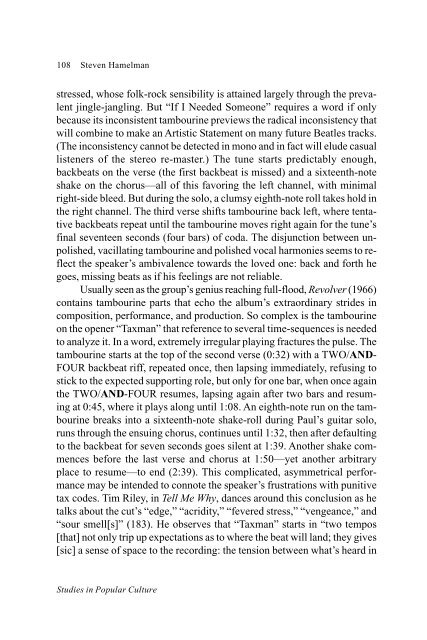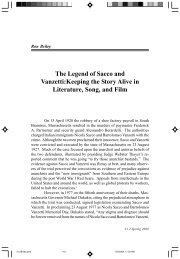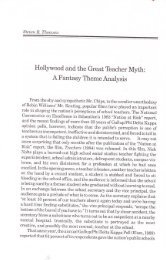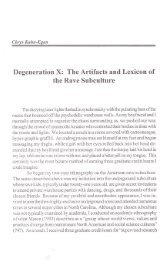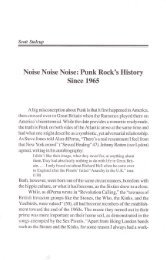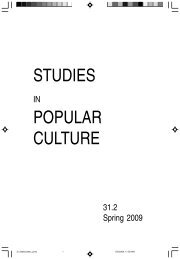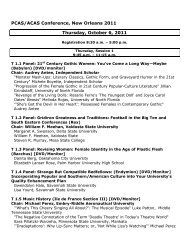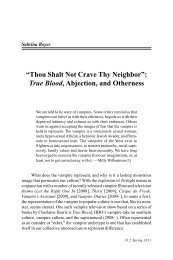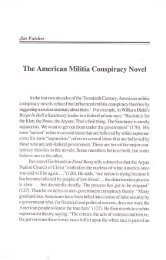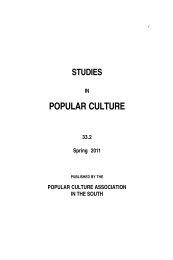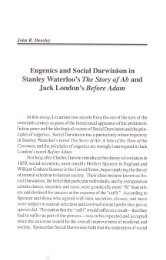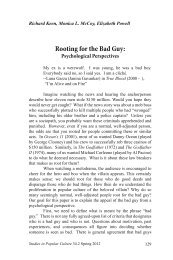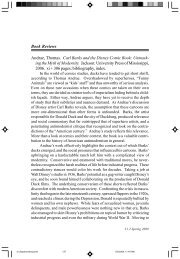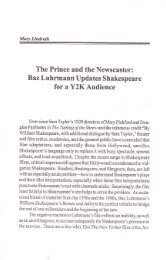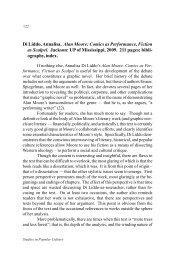The Beatles and the Art of the Tambourine - Popular/American ...
The Beatles and the Art of the Tambourine - Popular/American ...
The Beatles and the Art of the Tambourine - Popular/American ...
Create successful ePaper yourself
Turn your PDF publications into a flip-book with our unique Google optimized e-Paper software.
108 Steven Hamelman<br />
stressed, whose folk-rock sensibility is attained largely through <strong>the</strong> prevalent<br />
jingle-jangling. But “If I Needed Someone” requires a word if only<br />
because its inconsistent tambourine previews <strong>the</strong> radical inconsistency that<br />
will combine to make an <strong>Art</strong>istic Statement on many future <strong>Beatles</strong> tracks.<br />
(<strong>The</strong> inconsistency cannot be detected in mono <strong>and</strong> in fact will elude casual<br />
listeners <strong>of</strong> <strong>the</strong> stereo re-master.) <strong>The</strong> tune starts predictably enough,<br />
backbeats on <strong>the</strong> verse (<strong>the</strong> first backbeat is missed) <strong>and</strong> a sixteenth-note<br />
shake on <strong>the</strong> chorus—all <strong>of</strong> this favoring <strong>the</strong> left channel, with minimal<br />
right-side bleed. But during <strong>the</strong> solo, a clumsy eighth-note roll takes hold in<br />
<strong>the</strong> right channel. <strong>The</strong> third verse shifts tambourine back left, where tentative<br />
backbeats repeat until <strong>the</strong> tambourine moves right again for <strong>the</strong> tune’s<br />
final seventeen seconds (four bars) <strong>of</strong> coda. <strong>The</strong> disjunction between unpolished,<br />
vacillating tambourine <strong>and</strong> polished vocal harmonies seems to reflect<br />
<strong>the</strong> speaker’s ambivalence towards <strong>the</strong> loved one: back <strong>and</strong> forth he<br />
goes, missing beats as if his feelings are not reliable.<br />
Usually seen as <strong>the</strong> group’s genius reaching full-flood, Revolver (1966)<br />
contains tambourine parts that echo <strong>the</strong> album’s extraordinary strides in<br />
composition, performance, <strong>and</strong> production. So complex is <strong>the</strong> tambourine<br />
on <strong>the</strong> opener “Taxman” that reference to several time-sequences is needed<br />
to analyze it. In a word, extremely irregular playing fractures <strong>the</strong> pulse. <strong>The</strong><br />
tambourine starts at <strong>the</strong> top <strong>of</strong> <strong>the</strong> second verse (0:32) with a TWO/AND-<br />
FOUR backbeat riff, repeated once, <strong>the</strong>n lapsing immediately, refusing to<br />
stick to <strong>the</strong> expected supporting role, but only for one bar, when once again<br />
<strong>the</strong> TWO/AND-FOUR resumes, lapsing again after two bars <strong>and</strong> resuming<br />
at 0:45, where it plays along until 1:08. An eighth-note run on <strong>the</strong> tambourine<br />
breaks into a sixteenth-note shake-roll during Paul’s guitar solo,<br />
runs through <strong>the</strong> ensuing chorus, continues until 1:32, <strong>the</strong>n after defaulting<br />
to <strong>the</strong> backbeat for seven seconds goes silent at 1:39. Ano<strong>the</strong>r shake commences<br />
before <strong>the</strong> last verse <strong>and</strong> chorus at 1:50—yet ano<strong>the</strong>r arbitrary<br />
place to resume—to end (2:39). This complicated, asymmetrical performance<br />
may be intended to connote <strong>the</strong> speaker’s frustrations with punitive<br />
tax codes. Tim Riley, in Tell Me Why, dances around this conclusion as he<br />
talks about <strong>the</strong> cut’s “edge,” “acridity,” “fevered stress,” “vengeance,” <strong>and</strong><br />
“sour smell[s]” (183). He observes that “Taxman” starts in “two tempos<br />
[that] not only trip up expectations as to where <strong>the</strong> beat will l<strong>and</strong>; <strong>the</strong>y gives<br />
[sic] a sense <strong>of</strong> space to <strong>the</strong> recording: <strong>the</strong> tension between what’s heard in<br />
Studies in <strong>Popular</strong> Culture


